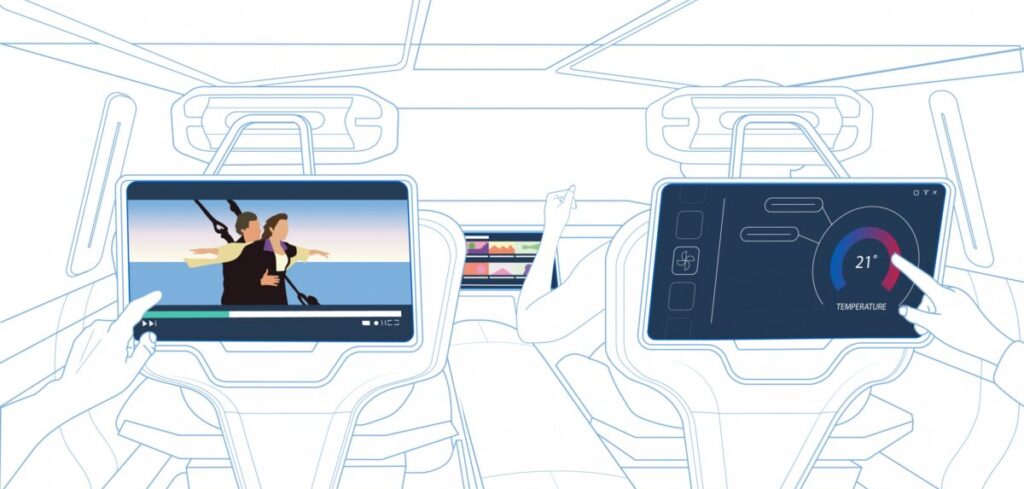According to software specialist VNC Automotive, where once rear seat entertainment (RSE) systems were the preserve of passengers in high-end, premium vehicles, they are on the verge of becoming mainstream in lower vehicle categories, as the requirement for vehicle-integrated hardware is reduced.
The company states that a gradual move toward advanced levels of autonomous functionality is set to herald the biggest shift yet in the way the technology is integrated and utilized. Some of these steps could even make physical screen technology redundant.
“Future adoption of Level 3, 4 and 5 autonomous vehicles could result in us spending more time in our cars, but less time physically driving them,” says Peter Galek, VNC Automotive’s product engineering director. “Ultimate removal of driver accountability and road-focus has the potential to completely alter the role of RSE and the vehicle in general. The advent of digital TV, streaming and gaming has already altered the way we consume media at home and on the move, and this trend is gradually becoming more prevalent in our personal transport, too.”
The ongoing pandemic has played its part in accelerating the evolution of media consumption habits – data from the UK’s Ofcom (communications regulator) suggests that the country’s streaming services alone have enjoyed 12 million new sign-ups during Covid-19 and that viewing times on these services have risen by 71% on 2019’s figures.
Galek adds that RSE has already become less of a premium-only product and is a key factor influencing the decision of car buyers of many popular models. With this in mind, VNC Automotive has launched its Cobalt Share solution, which targets RSE and BYOD (bring your own device) users by sharing multimedia content from multiple mobile sources to vehicle screens, which hints at the evolving requirements of car passengers in 2021.
“We are living in a ‘one-click society’, be that for ordering items for next-day delivery, operating home devices or vehicle connectivity – we have been spoiled by convenience and it’s imperative that this is reflected in ease of use, even as technology evolves and functionality is added,” he observes. “An ability to swiftly connect to a vehicle’s screens, as widespread travel resumes, means that work doesn’t have to be completed at home or an office, but remotely from the back of a taxi or form of executive travel.”
In the future, he feels that this could promote collaborative working as business is less affected by travel; connecting seamlessly between home or when on the move, checking emails or joining meetings streamed to common screen workstations viewed by multiple stakeholders in an executive MPV, for example, or even a Level 5 autonomous vehicle with the driver involved, too. “The basic technology to provide this level of experience and connectivity exists, and we would expect demand to increase as customer awareness grows and the working environment continues to evolve as we emerge from the pandemic.”
 Galek explains that format commonality will be vital for a seamless multi-vehicle integration, as compatibility issues between device manufacturers or auto makers’ proprietary systems will provide a short- to mid-term challenge to overcome. Advancements to mobile networks such as 5G offer potential, however. “We could see a scenario whereby enhanced synchronization enables the vehicle to become a crucial part of a passenger’s network of inter-connected devices that make up their work or personal hub. Rather than simply streaming from your phone to a screen, you’re seamlessly immersed into the mobile environment.”
Galek explains that format commonality will be vital for a seamless multi-vehicle integration, as compatibility issues between device manufacturers or auto makers’ proprietary systems will provide a short- to mid-term challenge to overcome. Advancements to mobile networks such as 5G offer potential, however. “We could see a scenario whereby enhanced synchronization enables the vehicle to become a crucial part of a passenger’s network of inter-connected devices that make up their work or personal hub. Rather than simply streaming from your phone to a screen, you’re seamlessly immersed into the mobile environment.”
From a display perspective, through modern LCD or OLED technologies, vehicle screen resolution is advancing at a considerable rate. However, the added cost of screen supply and integration, hardware certification and crash safety validation provide challenging barriers to adoption. Automotive applications must also typically be able to withstand temperature extremes of -40°C to 85°C, plus offer touchscreen functionality including haptic feedback. According to Galek, this represents an opportunity rather than a challenge.
RSE is a chance for vehicle manufacturers to offer differentiation and step away from the shared-parts feel of some premium ergonomics and interactive systems. Possibilities such as zonal, smart audio controls to adjust personal volumes and focus content already enhance the in-vehicle experience, but the potential to bring such functionality under control of a device or app takes this to the next level of integration. Such connectivity also offers a future-proofing opportunity, enabling remote updates and upgrades via mobile internet or cloud-based technology to avoid building in inherently outdated technology – the latest interface or fully bespoke layout, welcome screen or personalized settings are all potential realities.
“A car’s sound system is already often the best system owned by a customer,” Galek suggests. “If vehicles are to evolve to become, with the integration of autonomous functionality, a mobility space as opposed to a traditional car, could we see the emergence of home-from-home entertainment systems?
“The future may look beyond screens in the rear, to projections on to any flatform surface, such as the windows, and incorporate augmented reality technology to truly make the vehicle an extension of your living or workspace.”



